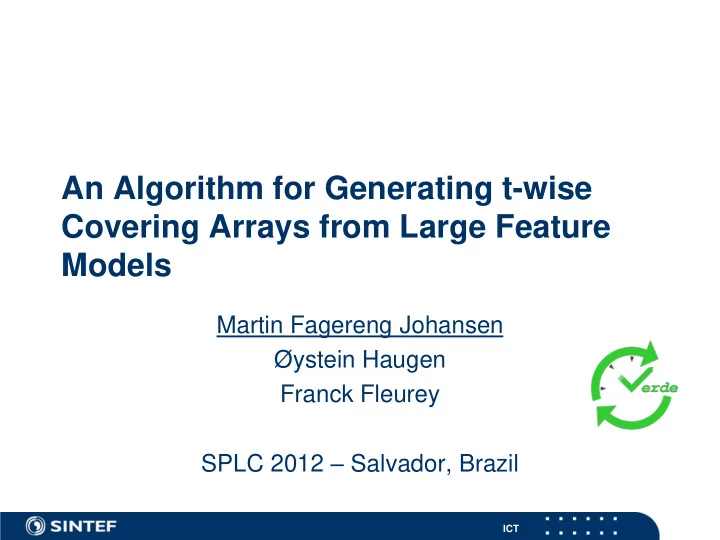

An Algorithm for Generating t-wise Covering Arrays from Large Feature Models Martin Fagereng Johansen Øystein Haugen Franck Fleurey SPLC 2012 – Salvador, Brazil ICT
Example Product Line: The Eclipse IDEs ICT 2
Constraints Between Features 356,352 possible products ICT 3
Product Line Verification How do we gain confidence that any valid product works? ICT 4
Faulty Features Unit tests may find faults inside a single feature. n test suites required for a product line with n features. What about faulty cooperation between features? What if they interact incorrectly? ICT 5
Interaction Faults 2-wise interaction fault reproducible by including 2 specific features the others do not matter ICT 6
Interaction Faults 3-wise interaction fault reproducible by including 3 specific features the others do not matter ICT 7
Empirics Show: Kuhn et al. 2004: Most bugs can be attributed to the interaction of a few features. ICT 8
Covering Arrays Mathematical property: Only a few products needed to cover all simple interactions Other examples (pair-wise testing): For the "e-shop product line" with 287 features: 21 products For the Linux kernel with almost 7,000 features: 480 products ICT 9
Combinatorial Interaction Testing (CIT) scalability issue 1. Generate a covering array Can be reused until the feature model is changed 2. Build each product 3. Apply a single system testing technique to each product Note: CIT was originally intended for single system testing Covering arrays over input instead of interactions. ICT 10
Background Our MODELS 2011 paper concludes: Covering array generation is tractable in practice. Difficult to satisfy FMs imply no products to sell, which is absurd. An efficient algorithm was not provided. 2-wise testing limit: about 500 features 3-wise testing limit: about 200 features An efficient algorithm is contributed in this paper. 2-wise testing Now works for the Linux Kernel feature model (6888 features) 3-wise testing Now works for the eCos feature model (1244 features) (An optimized C/C++ implementation + some good hardware should work even for the Linux Kernel feature model.) ICT 11
Overview of the Algorithm ICPL t Implementation Supports CSV-file Simple XML Feature Models (SXFM) GUI DSL DIMACS CVL (Proposed OMG standard) ICT 12
Groundwork Data Structures a = (feature, included) – an assignment e = {a 1 , a 2 , ..., a t } – a t-set – a set of t assignments T t – the set of all t-sets I t – the set of all invalid t-sets U t – the set of all valid t-sets (the "universe") C – configuration – a set of assignments, one for each feature CA t – {C 1 , C 2 , …, C x } – a Covering Array of strength t Equations 𝑢 = 2 𝑢 𝑔 𝑈 𝑢 , i.e. 95 million pair-wise interactions for the Linux kernel Empirically, 𝐽 𝑢 ≪ 𝑉 𝑢 𝐷𝐵 𝑢−1 ⊆ 𝐷𝐵 𝑢 , thus, generating 𝐷𝐵 𝑢−1 before 𝐷𝐵 𝑢 is an option. ICT 13
Recursive generation of covering arrays of lesser strength Greedy Loop Fit as many as possible Remove those covered … and repeat until all inter- actions are covered Not parallel ICT 14
Pick an interaction Skip if covered Quick! Does it fit the product? yes no Make sure all features are assigned Not parallel ICT 15
Algorithm 3 Is the assignment valid? Algorithm 7 For all uncovered interactions Is the interaction covered? Algorithm 8 Pick an interaction Check if it is invalid These are data-parallel sub-algorithms ICT 16
Compared to Other Tools ICPL – our new algorithm CASA – Simulated annealing algorithm by Garvin et al. MoSo-Polite – algorithm by Oster et al. IPOG – algorithm by Lei et al. Experiment Machine Could execute 6 threads in parallel 32 GiB RAM ICT 17
Time Taken to Generate Statistic estimates The 𝑑 in 𝑃(𝑔 𝑑 ) where 𝑔 is the number of features 4 5 3 ICPL 4 3 2 CASA 3 2 2 IPOG* 1 1 1 MoSo- 0 0 0 Polite 3-wise 2-wise 1-wise ICT 18
Size of Covering Arrays 70 350 800 ICPL 60 300 600 50 250 CASA 40 200 400 30 150 IPOG* 20 100 200 10 50 MoSo- 0 0 0 Polite 1-wise 2-wise 3-wise ICT 19
Large Feature Models … ICT 20
Summary Our contribution A scalable algorithm for t-wise (1-3) covering array generation An empirical evaluation and comparison Implementation available The implementation is available as open source (EPL) Experiments are reproducible All the data is available All 28,500 measurements available for the paper's resource website + charts and summaries ICT 21
Recommend
More recommend